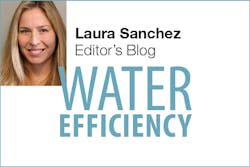A clear understanding of water main break rates can be helpful for assessing pipe performance and making key decisions related to water infrastructure asset management.
In March, Utah State University’s Buried Structures Laboratory published a new study on pipe break rates. The report, titled, “Water Main Break Rates In the USA and Canada: A Comprehensive Study,” covers valuable topics such as aging infrastructure, corrosion, pipe materials, and condition assessment.
The study presents asset management data and pipe material performance records gathered from over 300 utilities from 48 states that can be used to support infrastructure repair or replace decision-making. According to the author, Dr. Steven Folkman, “This report provides greater insight into the drivers of the aging water infrastructure crisis and offers data which utilities can use to benchmark pipe material performance. It will be a valuable asset management planning tool for water utilities.”
We recently reached out to Paul Murray (PM), Echologics applications engineer at Mueller Water Products, for his perspective on the report’s findings.
Water Efficiency (WE): According to the study, break rates on cast iron pipes have increased 27% between 2012 and 2018. How can leak detection help prevent pipe failure?
Paul Murray (PM): Certain cast iron pipe breaks cause dramatic failures quickly, but more often leaks develop gradually over time. The severity of each pipe break depends on pipe material and installation specifics.
Leak detection, and more importantly leak monitoring, can reduce the damage associated with the breaks that develop into failures. Addressing leaks in a planned manner before they develop is often a cost-effective program. For example, utilities in the northeast are focused on repairing leaks in the summer months because each leak repaired reduces the risk of an emergency repair near Christmas when the cold weather can add load to the pipes and cause leaks to grow.
WE: The study reports that smaller utilities have a higher rate of water main failure than larger ones. What condition assessment strategies would you suggest for smaller utilities?
PM: I see good outcomes from our smaller utility partners who keep their asset management strategies simple and leverage the knowledge of their operations team. Often, in smaller systems, repair crews have a lot of network knowledge that can help capital planning. Most condition assessment tools are expensive and invasive—they go inside the pipe. While high-cost approaches may be warranted on critical transmission pipelines, a non-invasive acoustic condition assessment tool such as ePulse technology requires minimal site preparation and has been proven effective at measuring pipe condition and identifying leaks in water networks. The survey level data that the technology delivers is usually a good, affordable match for smaller utilities that need reliable field data to improve pipe replacement decisions.
Water networks change and upgrade slowly. As per Folkman’s study, utilities are replacing less than 1% of their pipe network every year. This means utilities need to maximize the reduction in future breaks from their replacement program. Based on our testing of cast iron pipe networks, we’ve found less than 10% of the pipes contribute to over 50% of the structural failure risk. Combining field measurements with the knowledge of water operators on the ground can be a cost-effective way to gradually maintain and improve the pipe network.
WE: How can monitoring technologies support condition assessment?
PM: As we’re seeing in Folkman’s study, cast iron and asbestos cement pipes have increasing break rates. Leak monitoring for distribution pipes is a proven technology that’s been used effectively in water networks for over a decade. Distribution pipe leak monitoring was enabled by developments in sensor technology and improved communications networks. This follows the IoT trend towards more connectivity in everything from cars to refrigerators.
Leak monitoring offers network managers a measurable tool to pursue new pipe asset management strategies, such as:
- Extend asset life: Having early awareness of leakage or breaks enables network managers to action repairs and maintain an acceptable level of service on older pipes.
- Reduce damage liability: Monitoring gives asset managers awareness to leaks near critical infrastructure (for example, subways and highways). Undetected leaks can degrade infrastructure over time resulting in costly emergency repairs.
- Plan repairs: Repairing leaks in good weather with clear customer communications is easier and more cost effective.
- Reduce real losses and improve network sustainability.
WE: The report indicates that 45% of utilities have condition assessment programs in place. Should that percentage be higher?
PM: Yes. Water utility staff and asset managers keep getting asked to do more with less. Condition assessment is really the place where utilities can do exactly that. An asset manager told me that replacing good pipe is like digging up money and then throwing it away. A typical utility with cast iron or asbestos cement pipes saves $10 in capital spending for each dollar they invest in ePulse pipe condition assessment.
Regulators and ratepayers are asking for more detail on capital projects especially when it’s tied to a water rate increase. We need to start thinking about replacing a pipe with 20 years of service life still left in the same way as replacing a 5-year-old pickup truck that still runs great. It’s just not necessary. Pipe condition assessment can identify which capital investments are needed and those that will offer the best payback for a utility.
Reducing operational expenses by preventing leaks or deferring capital expenditures offers a clear business case to invest in pipe condition assessment in addition to the social and environmental benefits associated with investing in a sustainable pipe network.
